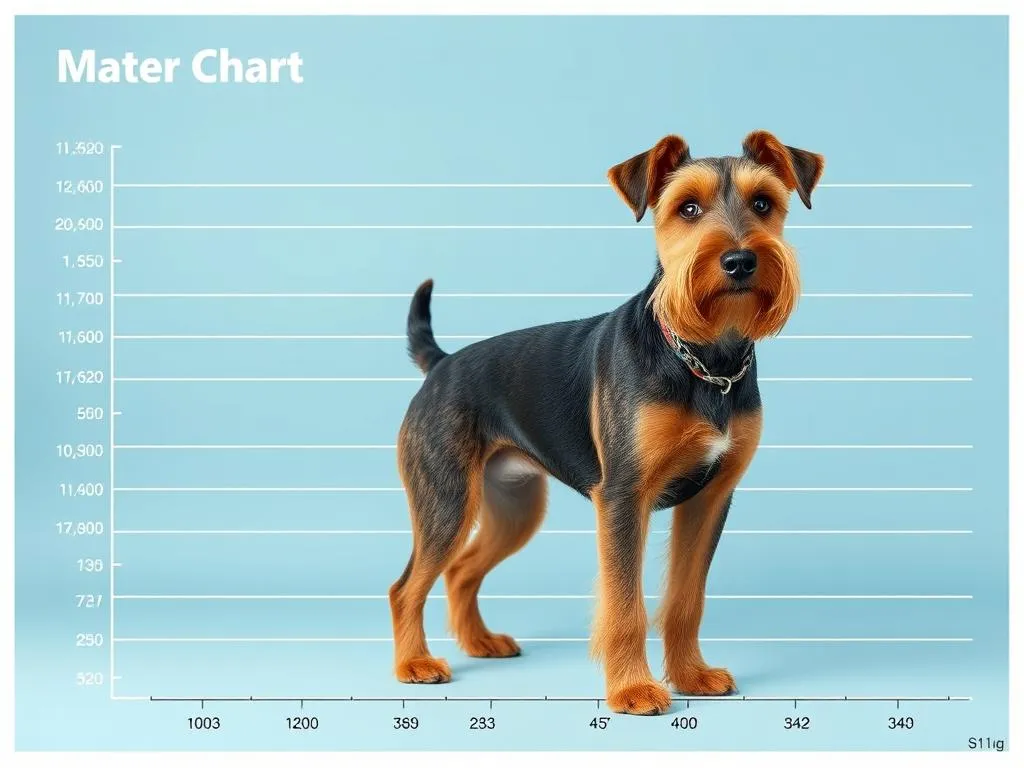
Introduction
The Airedale Terrier is renowned for being the largest of the terrier breeds, combining a dignified appearance with an energetic and playful temperament. Originating from the Aire Valley in Yorkshire, England, these dogs were initially bred for hunting otters and rats, showcasing their versatility and intelligence. Today, they serve various roles, from family companions to service dogs, thanks to their unique traits and adaptability.
Understanding the Airedale Terrier size weight growth chart is essential for prospective dog owners. It not only helps in tracking their growth but also has significant health implications. Keeping an eye on an Airedale’s size and weight aids in proper training and care, ensuring a happy and healthy life for your furry friend.
Airedale Terrier Overview
Breed Characteristics
Airedale Terriers are distinguished by their striking physical traits and charming personality.
-
Physical Traits: They have a dense, wiry coat that is typically tan, with a black saddle. The coat requires regular grooming to maintain its texture and appearance. Airedales possess distinctive V-shaped ears that fold over and a long, straight tail that is usually docked. Their body is well-proportioned, exuding an air of confidence and strength.
-
Personality Traits: Airedales are known for their intelligence, loyalty, and playful nature. They are generally friendly and good with children, making them excellent family pets. Their temperament is often described as spirited yet calm, allowing them to adapt well to various environments.
Purpose and Function
Historically, Airedales played the role of hunting and herding dogs, showcasing their agility and keen senses. In modern times, they have transitioned into family pets and service animals, excelling in various tasks due to their trainable nature and versatility.
Airedale Terrier Size and Weight
Standard Size Ranges
When considering an Airedale Terrier size weight growth chart, it’s important to understand the standard size ranges for this breed.
-
Height: Adult male Airedales typically stand between 21 to 23 inches tall at the shoulder, while females are slightly smaller, ranging from 20 to 22 inches.
-
Weight: Male Airedales usually weigh between 50 to 65 pounds, whereas females tend to weigh between 40 to 55 pounds. These variations are crucial for potential owners to consider, especially regarding space and lifestyle compatibility.
Factors Influencing Size and Weight
Several factors can influence the size and weight of an Airedale Terrier:
-
Genetics: The genetic background of a dog plays a vital role in determining its size. Breeding practices can result in variations, so it’s essential to choose a reputable breeder.
-
Nutrition and Diet: A balanced diet is crucial during the growth stages. Puppies require specific nutrients for proper development, while adult dogs need a diet that maintains their weight and health.
-
Exercise and Activity Levels: Airedales are energetic dogs that thrive on regular exercise. Adequate physical activity helps maintain a healthy weight and promotes overall well-being.
Airedale Terrier Growth Chart
Growth Stages
An Airedale Terrier size weight growth chart can be divided into several growth stages:
-
Puppy Stage (0-8 Weeks): This is the critical period for socialization. Puppies are usually weaned by 6-8 weeks and should start their journey with their new families around this time.
-
Adolescence (8 Weeks to 1 Year): Rapid growth occurs during this stage. Airedales may exhibit increased energy and curiosity, requiring consistent training and socialization.
-
Adulthood (1 Year and Above): By this stage, Airedales reach their full size and weight. They are typically more settled and easier to manage.
Growth Chart Table
| Age Range | Male Height (inches) | Male Weight (pounds) | Female Height (inches) | Female Weight (pounds) |
|---|---|---|---|---|
| 0-8 Weeks | 8-12 | 5-10 | 7-11 | 4-9 |
| 2-4 Months | 12-15 | 15-25 | 11-14 | 10-20 |
| 6 Months | 16-20 | 25-40 | 15-19 | 20-30 |
| 8 Months | 18-22 | 35-50 | 17-21 | 25-40 |
| 1 Year | 21-23 | 50-65 | 20-22 | 40-55 |
What to Expect at Each Stage
During the growth process, you’ll notice various milestones:
-
Puppy Stage: Puppies are generally playful and curious. Ensure they receive appropriate vaccinations and social experiences.
-
Adolescence: This stage can be challenging due to heightened energy levels. Consistent training and mental stimulation are essential to curb any behavioral issues.
-
Adulthood: By now, Airedales should have settled into their routine. Regular vet check-ups and maintaining a balanced diet are crucial to prevent obesity and other health issues.
Health Considerations Related to Size and Weight
Common Health Issues
Airedales, like any breed, are susceptible to certain health concerns that are often linked to their size and weight:
-
Size-Related Health Problems: Larger breeds can be prone to conditions such as hip dysplasia and elbow dysplasia. Regular vet visits and screenings can help catch these issues early.
-
Obesity and Its Impact: Maintaining a healthy weight is crucial for preventing obesity-related health problems. Airedales are particularly prone to weight gain if not exercised adequately.
Preventative Measures
To ensure your Airedale remains healthy, consider the following measures:
-
Recommended Diet for Various Growth Stages: Puppies need a diet rich in protein and nutrients for growth. Adult Airedales require a balanced diet to maintain their weight and prevent obesity.
-
Importance of Regular Exercise: Daily walks, playtime, and mental stimulation are essential to keep an Airedale physically fit and mentally engaged.
-
Veterinary Check-Ups and Monitoring Growth: Regular veterinary visits are vital for monitoring an Airedale’s growth and addressing any health concerns promptly.
Training and Socialization
Importance of Early Training
Training is essential for Airedale Terriers, as their size and strength can make them challenging to handle if not properly trained.
-
Impact of Size and Strength on Training: Airedales are intelligent and eager to please, making them relatively easy to train when started early. Use positive reinforcement techniques to encourage good behavior.
-
Recommended Training Techniques for Airedales: Consistency is key. Start with basic commands and gradually increase the complexity of tasks. Socialization with other dogs and people is also crucial during this time.
Socialization Needs
Airedales thrive on social interaction.
-
Interaction with Other Pets and People: Early socialization helps them develop into well-rounded dogs. Introduce them to various environments, sounds, and people.
-
Activities That Promote Social Skills: Engage in group training classes or playdates with other dogs to enhance their social skills and confidence.
Conclusion
Understanding the Airedale Terrier size weight growth chart is vital for any prospective owner. Recognizing the standard size ranges and the factors influencing growth can help ensure your Airedale develops healthily and happily. Regular veterinary care, proper nutrition, and early training are essential components of caring for this remarkable breed.
As you embark on your journey with an Airedale Terrier, keep these factors in mind to provide the best possible environment for your new furry friend.
FAQs
-
What is the average weight of an adult Airedale Terrier?
The average weight for adult male Airedales ranges from 50 to 65 pounds, while females typically weigh between 40 to 55 pounds. -
How can I ensure my Airedale grows to a healthy size?
Provide a balanced diet, regular exercise, and routine veterinary check-ups to monitor growth and health. -
At what age does an Airedale Terrier stop growing?
Airedales generally reach their full height and weight by around 1 year of age, although they may continue to fill out until they are around 18 months old. -
What are the signs of obesity in Airedale Terriers?
Signs of obesity include difficulty in movement, excessive weight around the ribs and abdomen, and lethargy. Regular vet visits and monitoring diet can help prevent obesity.









